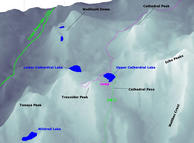 Tresidder Peak
Tresidder Peak
| Summary
| Image Gallery
| Trip Map
- Date: October, 1999.
- Route: Tresidder Peak via Upper Cathedral Lake.
- Total distance: ~10 miles.
|

Click Here
| 
| |
Click Here
for a TopoZone map of this trip.
Like most of the routes heading south from Tuolumne Meadows, the John Muir Trail
climbs monotonically from the dense forests of the meadows to alpine wonderland.
Cathedral Peak more than dominates the horizon -- it is the horizon!
The JMT approaches Cathedral Peak from the northeast, and then circumscribes
half of its base. Eventually the trail reaches a high glacial basin, one of
the most beautiful I've ever seen. The basin is ringed by some of the classic
climbs of Tuolumne Meadows: Medlicott Dome to the northwest, Cathedal Peak
to the northeast, Echo Peaks and Matthes Crest to the southeast, and Tresidder
Peak to the south. Upper Cathedral Lake perches placidly at 9600' just north
of Cathedral Pass. The glacier that carved these knife-edge peaks swept west,
over the small ridge which separates Upper Cathedral Lake from Lower Cathedral
Lake, and finally joined the larger glacier flowing through Tenaya Canyon.
We lunched at Upper Cathedral Lake, enjoying the balmy, windless weather
and the conspicuous dearth of mosquitoes. From there we hiked southwest
along the ridge which overlooks Lower Cathedral Lake, then cut over to the
north ridge of Tresidder Peak, where we set up camp in a particularly nice spot
at 10,000'. After ditching our packs, we made quick progress up the
ridge to the base of the north arete of Tresidder Peak (10,620'). The climb to
10,500' is walkable, but from our approach, some hands-and-knees were
required to bring us to the base of the north arete. I recall some scree,
but it probably could have been avoided by class 3-4 scrambling over very
solid granite.
We first tried to climb the north arete from the west. This was a mid-angle
(45+ degrees) slab climb for the most part. As we were inexperienced
(none for me) climbers, the lack of proper holds intimidated us, so
we deferred to a route on the south face. The west approach was probably
a 5.0-5.4 climb, but I don't remember it well enough to say for sure.
The south face boasts a nice dihedral crack, with a 30' pitch up to a good
ledge. The climbing was actually fairly easy, since the incline was about
70-80 degrees and the crack was very secure - full of holds and good for
arm/foot jams when the holds were sparse.
From the ledge, the climbing gets a bit harder to the summit. A seemingly
awkward traverse to another crack, followed by (I think) about 15 feet class 4
climbing. We didn't feel that the last short pitch was safe to do unroped,
so we stopped at the ledge and took in some fantastic views! To the south
and east: Cathedral Pass and the Cathedral Fork of Echo Creek. To the south
and east: Clouds Rest, Half Dome, and Yosemite Valley. To the north: Cathedral
Peak and Upper Cathedral Lake
The true summit of Tresidder Peak is actually the south arete, but the
north arete is very close in elevation.
Secor
rates both the south and north aretes as class 4, but describes a 5.9
pitch on the southeast face. I'm still not sure I would try to summit
the north arete unroped on our route. If I could do it over again (I might
have this opportunity) I would climb the dihedral unroped, set up an anchor
(belay the second climber if he/she wanted it), then climb the last pitch
to the summit on belay. The lower dihedral would require some huge protection,
while the summit block has many more cracks of varying sizes. A rappel
directly from the summit would be suitable.
From our campsite, we had great sunset views of Cathedral Peak and the
mighty Mount Conness, and surprisingly very little wind. All-in-all, we
both agreed that the panorama beheld on this trip was spectacular, easily
among the very best Yosemite has to offer. A classic trip!
The calm air made for awfully cold nights, but insects like this weather
even less than we do! The descent was almost shamefully short and simple.
© 2005
, Stanford Exploration Project
Modified: 11/18/05, 13:53:03 PST
, by morgan
Page Maintainer: morgan `AT' sep.stanford.edu

![]()

![]()

![]()

![]()

![]()

![]()

![]()

![]()

![]()

![]()

![]()

![]()

![]()

![]()

![]()

![]()

![]()

![]()

![]()

![]()

![]()

![]()

 Tresidder Peak
Tresidder Peak




